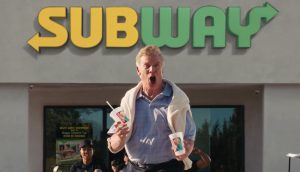When Brick Brewery purchased the Seagram trademark 18 months ago, the company made a tactical move to dust off its mature image and adopt a more youthful look that would appeal to adults aged 19 to 30.
So the company launched “a beginner’s guide to surviving the end of the world.” George Croft, president and CEO, Brick Brewery, tells MiC that the videos, which went live in July, have seen only an average of 1,600 views, leaving him feeling slightly disenchanted by the uptake of Seagram’s social media efforts.
The idea for “Seagram 2012” arose when its agency Unitas Reputation Agency recognized the trend in apocalyptic films building up to the end of the Mayan calendar, says Croft.
Croft stars in each video, giving viewers “words to live by, and stay alive by” and directing people to the Seagram Facebook page to get more George Croft tips. There will be eight videos in total when the campaign comes to an end on Dec. 21, which also happens to be the last day of the Mayan calendar.
“If you flip on the numbers, you can see we don’t have a tremendous amount of traction with this particular initiative,” he says, noting that the brand did not use any traditional media to support the videos. It wanted to be economical in its choice of media, seeing as this is a test campaign that would only live for ten months and then disappear, says Croft.
He added that the brand set aside $25,000 and doesn’t plan to spend any more dollars toward the initiative. “The push in the fall will be through our media partners, sort of a PR approach, which will generate trial. And if people think they’re interesting and funny, hopefully they’ll spread the word.”
Mike Robitaille, president, Unitas Reputation Agency says that Seagram has been seeding the videos on Twitter and Facebook, along with media kits to press and the brand’s personal networks. The videos were staged to release every two weeks for the first two months of the campaign, and the agency “made an assumption the media wouldn’t be immediately interested.” Though the campaign hasn’t seen many bites from the media, Robitaille plans to remain “adaptive and opportunistic [and to] keep knocking on doors until one opens.”
He says that successful viral video campaigns are generally the result of heavy conventional media support or picked up by influential media outlets, of which the brand is hoping for the latter. “We’ll be able to make a better determination of what worked toward the end of this program as it’s still very early to judge,” he says. “It’s fair, however, to say that paid media or PR would only accelerate interest. This program was an attempt to gain the greatest interest with the lowest-cost approach to both production and media.”
Croft notes that while traction hasn’t been as high as anticipated, and that the videos have thus far had no effect on sales, he would likely do it again if given the chance. “This brand’s role was to create a bit of news in the category and to contemporize the trademark. On that front, I’d say mission accomplished,” he adds.
[iframe_youtube video=”MLhCXMM6Jxo”]























